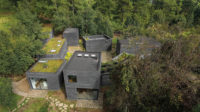
Architectural Record: There’s a competition and the clock is running. Do American architects have a shot at winning?
Claudia Perren: It’s an open international competition. Everyone has the same chance.
American architects are wary of open competitions, because too often the buildings don't get built.
That's not a possibility here. The federal government has pledged €12.5 million, and the state government another €12.5 million. That will cover the entire cost of building the museum.
So you don’t have to do any fund-raising at all?
I know that sounds weird to Americans, but it’s true. We are very lucky here that culture receives a lot of support.
I noticed that the jurors are mostly German.
The jury deliberations will be conducted in German. So most of the jurors are German-speaking, but we made sure there were some who are working internationally, like Jürgen Mayer- Hermann. And we have Chris Dercon, director of the Tate Modern in London, and Guido Hager, a Swiss landscape architect, on the jury.
What’s the aim of the first stage?
We’re asking people to focus on the concept: How do you position the museum in relation to the Bauhaus history and to the city of Dessau?
Tell me about the purpose of the new building.
We have a huge collection, 40,000 objects ranging from paintings to costumes, from chairs to entire rooms. But we’ve never had a way to show them comprehensively.
But you have exhibitions in the Bauhaus building.
Yes we do, but not on a big scale. Gropius designed it as a school building, not a museum, which means it doesn’t have the systems required to meet international conservation standards. And the things we would have to do to meet those standards would ruin the building, architecturally.
What kinds of museums do you like?
A good museum makes a statement about what’s contained in the building, about the character of the collection. So we're not looking for a "neutral" white box.
But aren’t white boxes precisely what the Bauhaus is about?
The white buildings that a lot of people think of when they hear "Bauhaus " were only a very small part of its output. It was a school for experimenting with art, design, and performance in new ways. And even when you look at the Bauhaus building, there are a lot s of different materials and colors.
So you’re not looking for another Bauhaus-style building?
We’re not looking for something that imitates what people think of as the Bauhaus style.
Will the building be part of a Bauhaus campus?
The site is in a public park right in the Center of Dessau, about 1 kilometer from the Bauhaus Building. But there are a number of other Bauhaus buildings in the city, including a social housing complex and a jobs center by Gropius. It will be quite important to integrate the new museum into this network of Bauhaus architecture.
Growing up in East Berlin, did you get to travel much?
To Eastern European countries – Russia, Czechoslovakia, Poland—but not to the other side. But the wall came down when I was 16, which, for me, was exactly the right time.
How was it exactly the right time?
I suddenly had the freedom to go and study wherever I wanted and to learn from the whole world, not just from a pre-selected part.
What important quality do you bring to the Bauhaus job?
My international experience. The Bauhaus was very international, with people coming from Switzerland, from Russia, from Israel and Hungary. Also, as a UNESCO World Heritage site, we have an international task to fulfill. You cannot just look at it from a German perspective.


Post a comment to this article
Report Abusive Comment